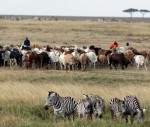Outbreaks of infectious disease make headlines around the globe almost daily. Viruses, bacteria, fungi, protozoa, and parasites have the potential to affect both humans and animals alike. A variety of infectious diseases can also be categorized as being zoonotic meaning they can be transmitted to other species. As reported by the Center for Disease Control (CDC) and the World Health Organization (WHO), at least 2.2 million human deaths annually are the direct result of zoonotic pathogens. As for domestic animals and wildlife, there is not an accurate number due to the under reporting of sickness in developing nations. For our focus, we will discuss those zoonotic diseases that affect wildlife, be it from domestic animal or human contact in captive and wild populations.
A close relative of measles, canine distemper is a paramyxovirus known to cause sickness in wild and domestic canids, wild felids, viverrids (genets, binturongs, civets), members of the weasel family, red panda, hyenas, procyonids (raccoons, coatis, kinkajous), and fin-footed marine mammals (seals, sea lions, walrus). Highly infectious, canine distemper continues to be a major threat to wildlife conservation. Spread commonly by the domestic dog, canine distemper contributed to the near extinction of the black-footed ferret in the United States, is a frequent cause of death in African wild dogs and lions, and may have been a significant factor in the total eradication of the thylacine or Tasmanian tiger. In addition, because this disease is so wide-spread it is often mistaken for others with similar symptoms like rabies. Although an effective vaccine was developed in 1950, the virus remains prevalent worldwide due to limited use or lack of vaccination programs.
domestic canids, wild felids, viverrids (genets, binturongs, civets), members of the weasel family, red panda, hyenas, procyonids (raccoons, coatis, kinkajous), and fin-footed marine mammals (seals, sea lions, walrus). Highly infectious, canine distemper continues to be a major threat to wildlife conservation. Spread commonly by the domestic dog, canine distemper contributed to the near extinction of the black-footed ferret in the United States, is a frequent cause of death in African wild dogs and lions, and may have been a significant factor in the total eradication of the thylacine or Tasmanian tiger. In addition, because this disease is so wide-spread it is often mistaken for others with similar symptoms like rabies. Although an effective vaccine was developed in 1950, the virus remains prevalent worldwide due to limited use or lack of vaccination programs.
 Herpes viruses are members of a very large family of latent viruses that reoccur throughout the lifespan of an infected individual. Although there are species-specific herpes viruses, there are also those that cross-species and in doing so become deadly. Elephant endotheliotropic herpesvirus has been identified in both wild and captive Asian and African elephants. It is hypothesized that while each elephant species has specific strains of the virus they live within an animal of that species with no serious health effects, it is when a particular strain is transmitted to the other species that it almost always results in death. Similarly, a strain of herpes virus known to cause sickness in zebras was recently identified as the cause of death in polar bears at a zoo in Germany. However, in the wild these species would never cross paths, so it is possible that these types of infections are strictly held to captive wildlife.
Herpes viruses are members of a very large family of latent viruses that reoccur throughout the lifespan of an infected individual. Although there are species-specific herpes viruses, there are also those that cross-species and in doing so become deadly. Elephant endotheliotropic herpesvirus has been identified in both wild and captive Asian and African elephants. It is hypothesized that while each elephant species has specific strains of the virus they live within an animal of that species with no serious health effects, it is when a particular strain is transmitted to the other species that it almost always results in death. Similarly, a strain of herpes virus known to cause sickness in zebras was recently identified as the cause of death in polar bears at a zoo in Germany. However, in the wild these species would never cross paths, so it is possible that these types of infections are strictly held to captive wildlife.
Anthrax is a lethal bacterium known to cause sickness in humans and animals. Found on every continent, including Antarctica, Anthrax spores are very hardy and can live for years under extremely harsh environmental conditions. Most commonly documented infections occur in areas where domestic livestock and wild herbivores share grazing land via fecal/oral route. While vaccinations for Anthrax do exist, and successful treatment with antibiotic therapy has been proven, limited use allows for this disease to persist. Like with distemper, Anthrax poses a great threat to wildlife, endangered species of particular concern.
continent, including Antarctica, Anthrax spores are very hardy and can live for years under extremely harsh environmental conditions. Most commonly documented infections occur in areas where domestic livestock and wild herbivores share grazing land via fecal/oral route. While vaccinations for Anthrax do exist, and successful treatment with antibiotic therapy has been proven, limited use allows for this disease to persist. Like with distemper, Anthrax poses a great threat to wildlife, endangered species of particular concern.
 Chytrid is a species of fungus that is decimating the world’s amphibian populations. Thought to have originated from the release of infected African clawed frogs (who are themselves resistant) into non-native habitats, chytrid is solely responsible for the almost 90% decline in global amphibian numbers. Furthermore, humans have also been identified as carriers of Chytrid on field equipment and clothing. Interestingly, a recent report has shown that Chytrid has been transferred to different habitats on the feet of migratory birds, specifically Canada geese.
Chytrid is a species of fungus that is decimating the world’s amphibian populations. Thought to have originated from the release of infected African clawed frogs (who are themselves resistant) into non-native habitats, chytrid is solely responsible for the almost 90% decline in global amphibian numbers. Furthermore, humans have also been identified as carriers of Chytrid on field equipment and clothing. Interestingly, a recent report has shown that Chytrid has been transferred to different habitats on the feet of migratory birds, specifically Canada geese.
 Zoonotic diseases are global health risks for all species. Most importantly, for my line of work, they pose a great threat to wildlife conservation. Whether you are a field researcher or simply live near wildlife habitat,everyone has a part to play in the reduction of transmission of these pathogens. Vaccination programs for domestic animals are a huge contributing factor in disease prevention. Making sure to clean equipment and clothing when traveling into different wild areas can eliminate the introduction of non-native and unwanted viruses, bacteria, fungi, parasites, etc. into native populations. In addition, good communication via reporting any suspected sickness in encountered wildlife to the proper authorities can be instrumental to prevent possible epidemics from occurring.
Zoonotic diseases are global health risks for all species. Most importantly, for my line of work, they pose a great threat to wildlife conservation. Whether you are a field researcher or simply live near wildlife habitat,everyone has a part to play in the reduction of transmission of these pathogens. Vaccination programs for domestic animals are a huge contributing factor in disease prevention. Making sure to clean equipment and clothing when traveling into different wild areas can eliminate the introduction of non-native and unwanted viruses, bacteria, fungi, parasites, etc. into native populations. In addition, good communication via reporting any suspected sickness in encountered wildlife to the proper authorities can be instrumental to prevent possible epidemics from occurring.
